Hands on with the ASUS Fonepad, and ASUS PadFone Infinity
by Brian Klug on February 25, 2013 7:08 PM EST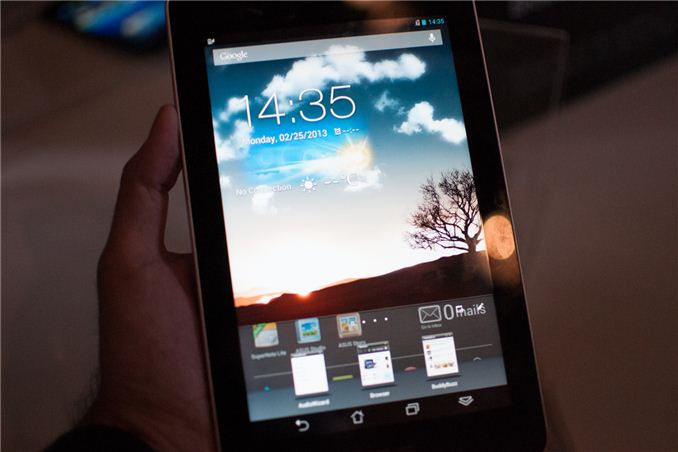
In its annual tradition at MWC, ASUS held a press conference off-site to introduce some of its mobile devices. The introductions are always interesting and typically unique in the marketplace. This year was no different.
To kick things off, ASUS introduced the Fonepad: a 7-inch Android 4.1.2 tablet that also serves as a phone. Samsung launched the Galaxy Note 8.0 earlier this week with a similar capability. While I don't expect many folks to want to hold a 7-inch tablet up to their face, having the ability to combine both tablet and smartphone functionality into one can be tempting. I can see the Fonepad being compelling if you don't make calls all that often but would rather carry a small tablet than a large smartphone, or if you are fine using a Bluetooth headset.
The device is pretty much a Nexus 7 but with a nice metal back. The dimensions are near identical to the Nexus 7 at 196.4mm x 120.1mm x 10.4mm with a weight of 340 grams. The display resolution remains 1280 x 800 and the IPS panel is LED backlit.
In a curious change of pace, ASUS integrated Intel's Atom Z2420 SoC (single-core + HT, 1.2GHz 32nm, PowerVR SGX 540). I'm curious to see how the single core, low-clocked Atom SoC does compared to Tegra 3 in a tablet. Driving all phone functionality is Intel's XMM 6265 baseband, with support for 850/900/1900/2100MHz WCDMA and 850/900/1800/1900MHz EDGE/GSM bands. There's support for 802.11b/g/n and BT 3.0.
The Fonepad features 1GB of LPDDR2 memory and 16GB of NAND on-board, with a microSD slot for additional storage expansion (a notable absence from the Nexus 7). There's an integrated 16Wh battery (like in the N7) and the device will be available in titanium gray and champagne gold (like the Transformer Prime).
The big selling point of the Fonepad is its price: $249. That's a pretty impressive deal for a full featured smartphone and 7-inch tablet in one. It's a bit of a quirky product, but I can definitely see the Fonepad filling a niche.
Next up is the ASUS PadFone Infinity. For those of you who aren't familiar with the PadFone concept, it's pretty simple. Take a phone that can dock into and power a tablet display and you have PadFone. The tablet part is strictly a display + battery, all compute and connectivity is driven by the phone element.
The PadFone Infinity takes a 5-inch 1080p Snapdragon 600 based smartphone running Android 4.2 and pairs it with a 10.1-inch 1920 x 1200 tablet dock (the PadFone Infinity Station). The phone weighs 141g and features an integrated 2400mAh battery, while the tablet dock weighs 530g and comes with a 5000mAh battery.
The phone integrates 2GB of LPDDR2-1066, and will come in both 32GB and 64GB versions. ASUS claims support for 802.11b/g/n and 802.11ac with WiFi Direct, BT 4.0 and NFC. Thanks to Qualcomm's baseband, there's full DC-HSPA+ and UE category 3 LTE support.
The PadFone features a 13MP rear facing camera with f/2.0 aperture lens and a 2MP front facing camera. When in tablet mode, the rear camera remains unimpeded while the front camera is replaced with a 1MP module.
Video out is supported via a Mobility DisplayPort interface (MyDP) that runs over the standard micro-USB port on the PadFone.


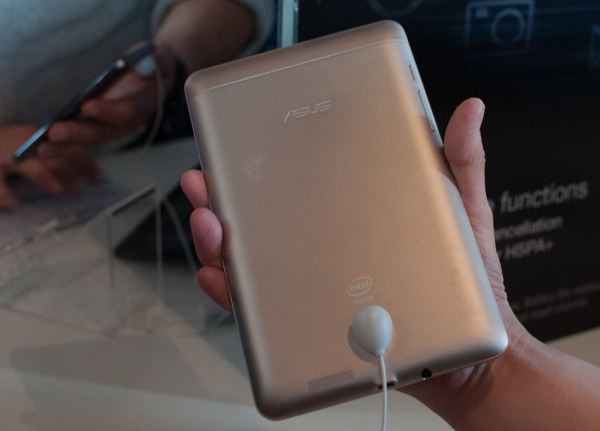

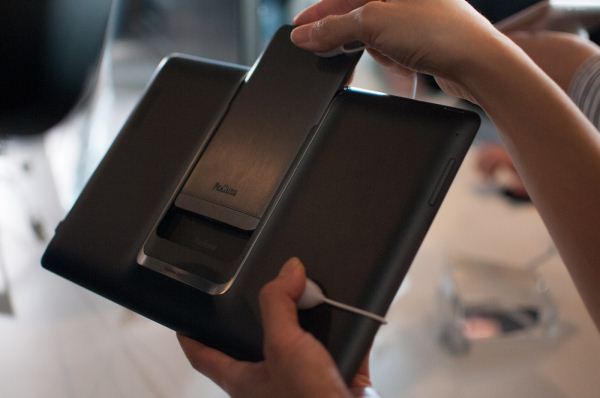
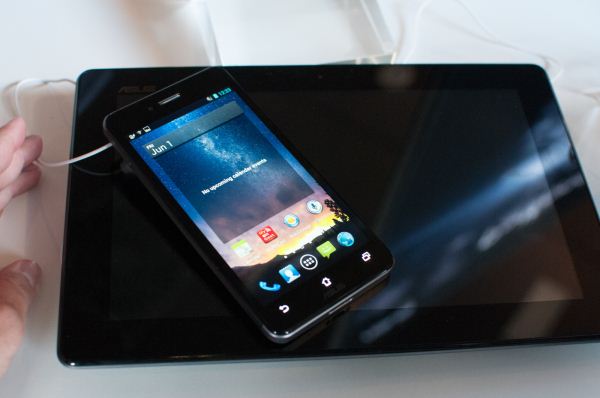
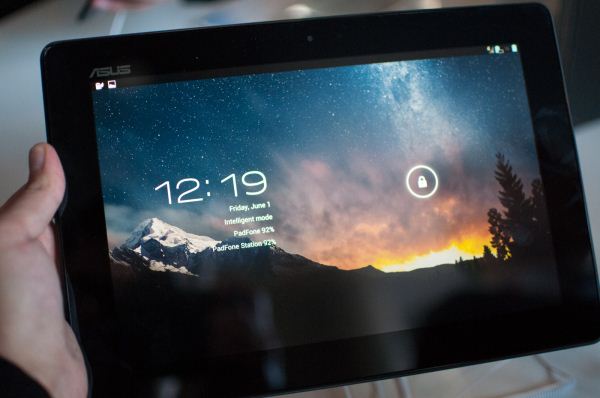














69 Comments
View All Comments
Zak - Monday, February 25, 2013 - link
A 7" phone? We now need a 5" tablet and say goodbye to logic and common sense. Off to play a game on my 4" Apple tablet... a.k.a. the iPod Touch.MonkeyPaw - Monday, February 25, 2013 - link
I would consider one. I bet lots of people just text and almost never talk and want a data plan. To me, just a data plan never made sense when the functionality was already there, even if you rarely use it.gseguin - Thursday, February 28, 2013 - link
Honestly, with the cost of baseband right now... why couldn't we reverse the thinking....Give all tablets / computers the comms required for a phone, create a lightweight bloototh earpiece that contains the SIM card and carrier info for connection, add comms chip in all car radios and you have a winner...
You thus carry around a very small piece of equipment that has enough memory for your digital content, but use the client's SoC for any apps. There's a few things to figure out, but still, no need for data share plans between phones and tablets, everything would simply be a 'voice+data enabled device' which requires an actual external blue-tooth SIM device for activation.
From home, I'd be talking through my ipad, then my car, then my computer through voip at work if that would be an option... this would require the earpiece to have a 4 year old SoC which could be made new with low battery requirements on new processes... So, why not a 5" phone 'extention'...
sumwand - Saturday, March 9, 2013 - link
it is not an earpiece but I think someday can be made to earpiece size :http://en.socblue.com/_d275434802.htm
amdwilliam1985 - Monday, March 11, 2013 - link
I agree, I rarely call anyone any more, I text/email everyone except my parents. gotta teach them how to do it.Flunk - Monday, February 25, 2013 - link
And I'll go make a call on my 14" phone.themossie - Tuesday, February 26, 2013 - link
"Vintage" Windows XP tablets are the new clamshell phones.Extra hipster 'cred' if you add an iOS theme :-)
CeriseCogburn - Monday, March 4, 2013 - link
Half clamshell. Clams have two shells, like a flip phone.I hate that when hipsters hipster out with some snappy name and the base concept is ensconced in a brainfart.
Apple had half clamshell pieces of crap. The whole industry had half clamshells.
No people, it's not the hot date aphrodesiac slide it in and slurp it down just the bottom half of the clam that is the clamshell.
Get out to any river and stick your hands in the underwater mud till you learn something about nature you hipster gasbags. Learning (incorrectly) about it at the gay clam bistro doesn't cut it.
seamonkey79 - Tuesday, March 5, 2013 - link
What? The 'vintage' WinXP tablets were a clamshell, with a top half clamshell and a bottom half clamshell. Top was screen, bottom was keyboard and other stuff.On top of that, I repeat 'What?'
evonitzer - Monday, February 25, 2013 - link
Easy jokes, all around. The price is amazing though. $250 for an unlocked phone! Selling these will not be difficult, despite the form factor oddity. I might buy one, after measuring my pockets (maybe buying new baggy jeans), and seeing what skin Asus has served up.Does the top just pop off to access the SIM and SD card slots? Rather weird looking, in that picture.